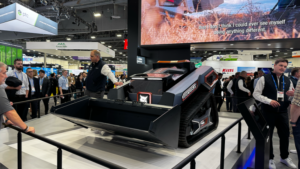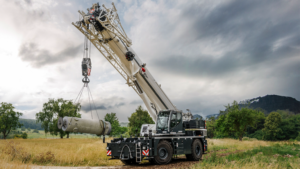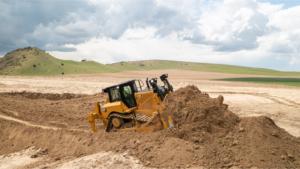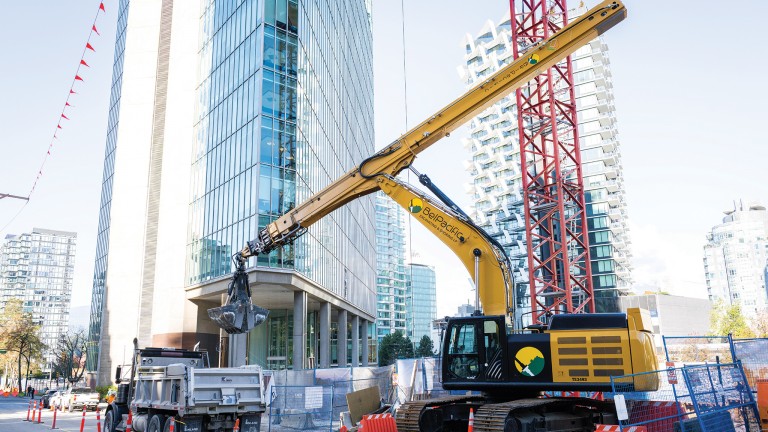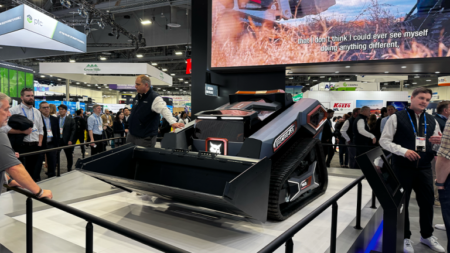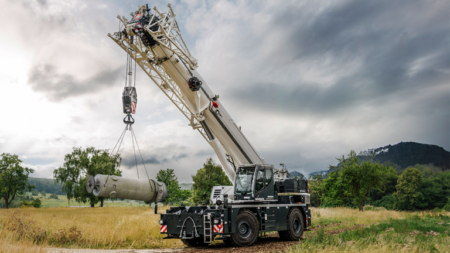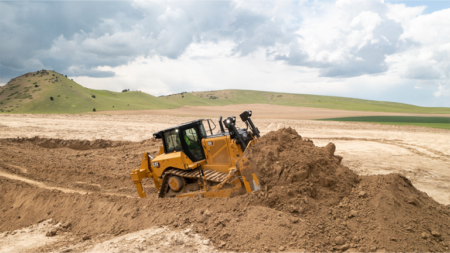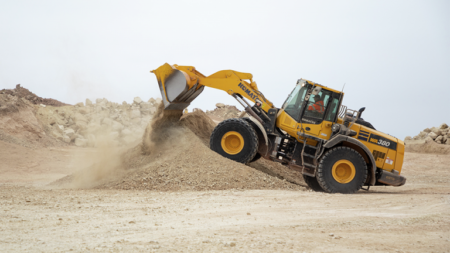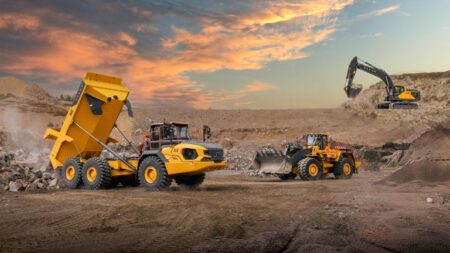BelPacific used its long reach excavator, a Cat 336E with a 60-foot arm, for excavation at 1515 Alberni Street.
Mack Plovie
Digging deep at 1515 Alberni Street
As high rises have become taller, excavations to accommodate them have become deeper, and 1515 Alberni is no exception — it holds the unofficial record of Vancouver’s deepest dig at 120 feet vertical. These deep vertical excavations are primarily for underground parking to meet bylaw requirements based on the number of residences in large urban towers.
On the 1515 Alberni project, BelPacific’s scope of work began by partnering with Pacific Blasting & Demolition Ltd, also part of NorLand Limited, to demolish a commercial rental unit building, large water feature, and two and a half levels of parkade. One of the many advantages of NorLand Limited, which includes 12 different companies, is that various divisions can vertically integrate for projects. Deep excavation work in downtown Vancouver can be incredibly challenging; contractors have to navigate adjacent active roadways, ground water, vertical excavation walls, inclement weather, developer schedules, and surrounding high rises.
After the demolition of structures on site, BelPacific began excavation from surface level, excavators worked to remove earth and expose walls on the perimeter of the excavation for drilling, anchoring, and shotcrete work as part of the shoring process. In order to excavate vertically, excavation walls are reinforced or “shored” with long anchor bars, grout, wire mesh, and shotcrete to effectively stabilize and prevent the walls from collapsing inward. As the excavation advances in depth, the process of excavating earth and shoring vertical walls along the perimeter of the excavation is repeated until target depth is achieved. This type of shoring is only temporary until the developer builds the concrete building up against the shored excavation.
On these deep digs, efficiently removing earth from the excavation is key to keeping the project on schedule. In the upper portion of the dig, conventional excavators both excavate and load out material into on-highway trucks. However, as the excavation advances deeper, so do the excavators, which required BelPacific to deploy its long reach excavator, a Cat 336E with a 60-foot arm. Sitting at street level, adjacent to the open excavation and looking over a vertical wall, this machine removed earth stockpiled by excavators within the vertical hole, and loaded tandem axle trucks and pups at street level. Earth excavated from the 1515 Alberni project was exported to a land-based disposal facility by conventional on-highway trucks.
A unique resource for BelPacific is its marine-based disposal facility. If excavated material meets a certain criteria, material exported from site can be sent to a central barge loading facility for disposal at sea by belly dump barges or relocated to another location that could use the material. BelPacific is one of the few deep excavation contractors in Vancouver that has a marine facility, allowing for faster removal of material as trucks don’t haul as far compared to land-based disposal facilities.
As the 1515 Alberni dig continued to progress, the long reach soon became ineffective due to its limited reach of 60 feet. To continue excavating material from the project, BelPacific brought in a custom-built Cat 349E L excavator with telescoping stick to excavate material to a final depth of 120 feet below street level.
“Our telescopic excavator’s overall performance allowed us to load trucks quickly and efficiently, thanks to the arm’s high-speed extension, retraction, and powerful pull-up force,” says Richard Christensen, site superintendent with BelPacific Excavating & Shoring LP.
The telescoping stick excavator, or telestick for short, was an instrumental part of the deep dig at 1515 Alberni. With a reach of 35 metres (115 feet), the machine sat adjacent to the vertical excavation. With an internal hydraulic ram it can extend a three-stage stick vertically to scoop up 1.7 cubic yards of loosely piled earth with the stick-mounted clamshell bucket. The stick then retracts, and the excavator swings over to load tandem axle trucks staged in an active laneway. The telestick is the only machine that can reach such depths to excavate material, averaging 400 cubic yards of earth each day. Once the excavation was completed to depth, the excavators that began the excavation at surface level and advanced it vertically downward were craned out. Overall, the 120-foot-deep excavation took a total of 15 months, removing 80,0000 cubic yards of earth to excavate for eight levels of parkade including elevator core and other building footings.
Read the full article here

